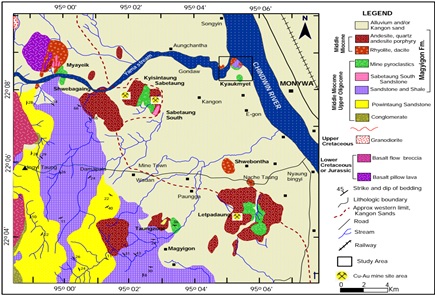Fluid Inclusion Study of Epithermal Quartz Veins from the Kyaukmyet Prospect, Monywa Copper-Gold Ore Field, Central Myanmar
DOI:
https://doi.org/10.25299/jgeet.2021.6.4.7726Keywords:
Kyaukmyet, epithermal quartz veins, fluid inclusions, formation temperature, paleo-depth, Monywa copper-gold ore fieldAbstract
The Kyaukmyet prospect is located near the main ore bodies of the Kyisintaung and Sabetaung high-sulfidation Cu-Au deposits, Monywa copper-gold ore field, central Myanmar. Lithologic units in the research area are of mainly rhyolite lava, lapilli tuff and silicified sandstone, mudstone and siltstone units of Magyigon Formation which hosted to be polymetallic mineralization. Our field study recorded that epithermal quartz veins are hosted largely in rhyolite lava and lapilli tuff units. Those quartz veins show crustiform, banded (colloform), lattice bladed texture and comb quartz. The main objectives of the present research in which fluid inclusion studies were considered to conduct the nature, characteristics and hydrothermal fluids evolution from the epithermal quartz veins. In this research, there are three main types of fluid inclusions are classified according to their phase relationship (1) two-phase liquid-rich inclusions, (2) the coexisting liquid-rich and vapor-rich inclusions, and (3) only vapor-rich inclusions. Microthermometric measurements of fluid inclusions yielded homogenization temperatures (Th) of 148–282 °C and final ice-melting temperature (Tm) of -0.2°C to -1.4°C . The value of (Tm) are equal to the salinities reaching up 0.35 to 2.07 wt % NaCl equiv. respectively. Estimation formation temperature of the quartz veins provide 190°C and 210°C and paleo-depth of formation are estimated to be between 130m and 210m. Petrography of fluid inclusion and microthermometric data suggest that fluid boiling as well as mixing processes were likely to be happened during the hydrothermal fluid evolution at the Kyaukmyet prospect. According to the characteristics of many parameters including petrography of fluid inclusion, microthermometric data, paleo-depth, evidence of quartz vein textures and types of hydrothermal alteration from the Kyaukmyet prospect allows to interpret these data to be the low-sulfidation epithermal system.
Downloads
References
Bodnar, R. ., Reynolds, T. ., & Kuehn, C. . (1985). Fluid inclusion systematics in epithermal systems. Reviews in Economic Geology, 2, 73–73.
Bodnar, R. J. (1993). Revised equation and table for determining the freezing point depression of H2O-NaCl solutions. Geochimica et Cosmochimica Acta, 57(3), 683–684.
Buchanan, I. J. (1981). Precious metal deposits associated with volcanic environments in the Southwest. In W. R. Dickson & W. D. Payne (Eds.), Relations of Tectonics to Ore Deposits in the Southern Cordillera: Arizona Geological Society Digest (Vol. 14, pp. 237–262).
Fournier, R. O., Berger, B. R., & Bethke, P. M. (1985). Geology and geochemistry of epithermal systems. SOC ECON GEOL REV ECON GEOL, 2, 45–62.
Haas, J. L. (1971). The effect of salinity on the maximum thermal gradient of a hydrothermal system at hydrostatic pressure. Economic Geology, 66(6), 940–946.
Htet, W. T. (2008). Volcanic-hosted gold-silver mineralization in the Monywa mining district, central Myanmar. Mandalay University.
Lee, H. Y., Chung, S. L., & Yang, H. M. (2016). Late Cenozoic volcanism in central Myanmar: Geochemical characteristics and geodynamic significance. Lithos, 245, 174–190. Elsevier.
Liu, C. Z., Chung, S. L., Wu, F. Y., Zhang, C., Xu, Y., Wang, J. G., Chen, Y., et al. (2016). Tethyan suturing in Southeast Asia: Zircon U-Pb and Hf-O isotopic constraints from Myanmar ophiolites. Geology, 44(4), 311–314. Geological Society of America.
Mitchell, A., Chung, S.-L., Oo, T., Lin, T.-H., & Hung, C.-H. (2012). Zircon U–Pb ages in Myanmar: Magmatic–metamorphic events and the closure of a neo-Tethys ocean? Journal of Asian Earth Sciences, 56, 1–23.
Mitchell, A. H. G., Htay, M. T., Htun, K. M., Win, M. N., Oo, T., & Hlaing, T. (2007). Rock relationships in the Mogok metamorphic belt, Tatkon to Mandalay, central Myanmar. Journal of Asian Earth Sciences, 29(5–6), 891–910.
Mitchell, A. H. G., Myint, W., Lynn, K., Htay, M. T., Oo, M., & Zaw, T. (2011). Geology of the High Sulfidation Copper Deposits, Monywa Mine, Myanmar. Resource Geology, 61(1), 1–29.
Morrison, G. W., Dong, G., & Jaireth, S. (1995). Textural Zoning in Epithermal Quartz Veins. Klondike. Klondike Exploration Services, Townsville, Australia.
Naing Oo, T., Harijoko, A., & Setijadji, L. D. (2021). Origin of the kyaukmyet low-sulfidation epithermal gold prospect, monywa district, central myanmar. Iraqi Geological Journal, 54(1), 1–18. Union of Iraqi Geoogists.
Roedder, E. (1984). Volume 12: fluid inclusions. Reviews in mineralogy (p. 646).
Searle, M. P., Noble, S. R., Cottle, J. M., Waters, D. J., Mitchell, A. H. G., Hlaing, T., & Horstwood, M. S. A. (2007). Tectonic evolution of the Mogok metamorphic belt, Burma (Myanmar) constrained by U-Th-Pb dating of metamorphic and magmatic rocks. Tectonics, 26(3), n/a-n/a.
Simmons, S. F., & Christenson, B. W. (1994). Origins of calcite in a boiling geothermal system. American Journal of
Science, 294(3), 361–400.
Wilkinson, J. J. (2001). Fluid inclusions in hydrothermal ore deposits. Lithos (Vol. 55).
Zaw, K. (1990). Geological, petrogical and geochemical characteristics of granitoid rocks in Burma: with special reference to the associated WSn mineralization and their tectonic setting. Journal of Southeast Asian Earth Sciences, 4(4), 293–335.
Zaw, K., Swe, Y. M., Myint, T. A., & Knight, J. (2017). Copper deposits of Myanmar. Geological Society Memoir (Vol. 48, pp. 573–588). Geological Society of London.

Downloads
Published
Issue
Section
License
Copyright @2019. This is an open-access article distributed under the terms of the Creative Commons Attribution-ShareAlike 4.0 International License which permits unrestricted use, distribution, and reproduction in any medium. Copyrights of all materials published in JGEET are freely available without charge to users or / institution. Users are allowed to read, download, copy, distribute, search, or link to full-text articles in this journal without asking by giving appropriate credit, provide a link to the license, and indicate if changes were made. All of the remix, transform, or build upon the material must distribute the contributions under the same license as the original.






